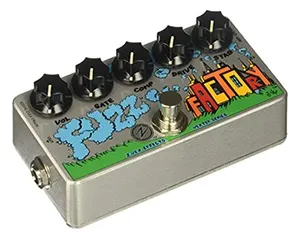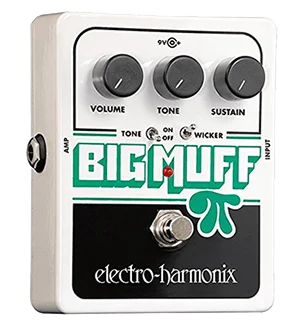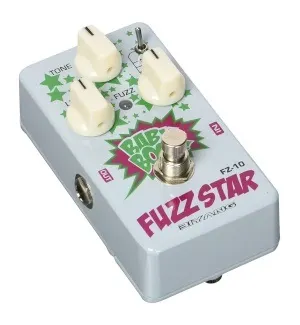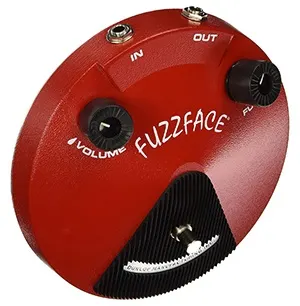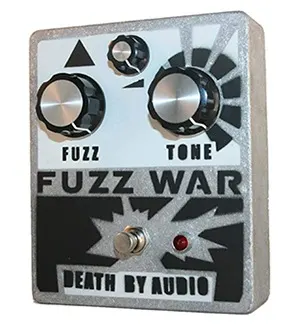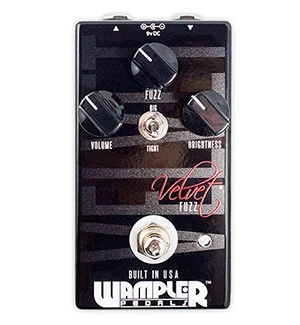The best fuzz pedal offers a sense of playability, along with its own knobs, where you can affect the high-gain distortion through your picking methods, varying the amount of the fuzz while maintaining the girth and bite of the effect. If you want the sound of a 10,000 pound, hair-covered bee buzzing through your busted amp, look no further than our top picks…
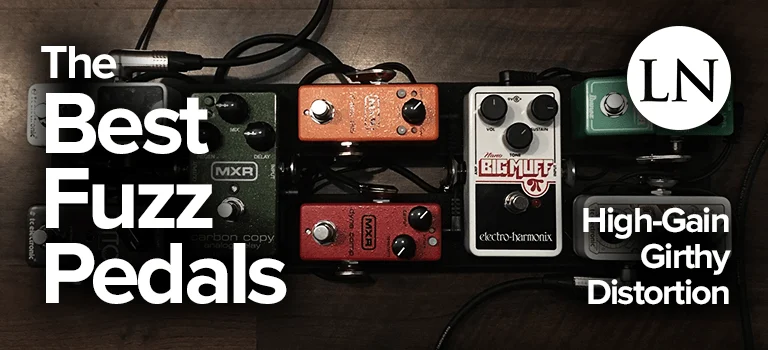
Distortion and overdrive are all fine and dandy, but sometimes you want to really push it to the limit with some ripping fuzz. And by ripping I mean the sound of the woofers in your amp being torn to shreds.
In a studio in 1961, Grady Martin played through a faulty preamplifier and that song became a smash hit. Companies scrambled to recreate the sound, but things really took off after 1964 when Dave Davies of The Kinks literally cut his speaker cones to create a similar sound. From there it was all history.
The hard clipped, square wave sound of the fuzz effect can be considered distortion taken to the extreme.
One might be tempted to call this a vintage effect if the popularity of guitarists like Jimi Hendrix, who used a fuzz pedal heavily, and Robby Krieger from The Doors didn’t persist to the point where current bands like The Smashing Pumpkins and The Beastie Boys are keeping the trend going.
Need more information? We have got you covered! Visit our FAQs section.
INCLUDED IN THIS GUIDE:
| ZVEX FUZZ FACTORY | Best Bang for Your Buck | Buy on Amazon |
| ELECTRO-HARMONIX BIG MUFF PI | Best of the Best | Buy on Amazon |
| BIYANG FZ-10 FUZZ STAR | Best Budget Pick | Buy on Amazon |
| EARTHQUAKER DEVICES HOOF | Best Fuzz Pedal for its Huge Gain & Volume | Buy on Amazon |
| DUNLOP JDF2 FUZZ FACE | Vintage Fuzz Pedal | Buy on Amazon |
| DEATH BY AUDIO FUZZ WAR | Most Versatile on the List | Buy on Amazon |
| WAMPLER VELVET FUZZ | Best Fuzz Pedal for Vintage Fuzz | Buy on Amazon |
ZVEX FUZZ FACTORY
The ZVEX Fuzz Factory started it all, leading the Fat Fuzz and Fuzz Factory 7 and many other models and mods. Most fuzz’s have three knobs, if that. This bad boy goes all the way to include very convenient features such as a Gate knob, which helps squelch any noise from this high-gain effect once your sustain has run its course.
In addition there’s a compressor that will either maintain the attack in your playing dynamics or squish them for a full on fat fuzz attack.
The Drive knob is your standard “more or less distortion” knob. The Stab knob refers to “stability.” It controls the amount of voltage delivered. Keeping it all the way to the right makes the pedal perform as expected but turning it further to the left emulates the battery or power supply beginning to fail.
You can get some interesting things going on with the voltage sag or you can ignore it altogether. It all depends on how crazy you want to get!
All of these features combine to create a newer classic that’s already spawning off variations, but none justify the doubled pricing. The original is still where it’s at.
Specs:
- Item Weight: 0.71 pounds
- Signal Format: Analog
- Voltage: 9 V
Pros:
- Great design and great features
- Offers a variety of effects
Cons:
- Not really suitable for beginners
ELECTRO-HARMONIX BIG MUFF PI
What list of best fuzz pedals would be complete without the Electro-Harmonix Big Muff Pi, especially with the new Tone and Wicker switches?
This beast has had a top-tier reputation since it came out in previous renditions and it’s still dominating the charts because it keeps getting better. The same fuzz supported by the Tone and Sustain knob (basically your distortion knob) remains, but now EHX has expanded the range of sound you can get out of these.
The Tone knob now has an on-off switch, meaning you can completely bypass the knob altogether and get a full frequency spectrum fuzz if you like. You can keep that engaged and roll the tone back to get a warmer fuzz but then flick the Wicker switch on, which opens up the high-end frequencies again.
So now, through a mixture of both you gain extra control over the mids where you can effectively scoop them out if you prefer. Or keep both engaged and get an extra crispy and crunchy fuzz. The options are endless now.
If you want to save about $20 and would prefer a regular sized pedal instead of this wider classic shape, you can check out the Big Muff Pi Nano, which isn’t a nano-sized but a normal sized one. The only compromise is you won’t get the new Tone & Wicker switches.
Specs:
- Item Weight: 1.5 pounds
- Signal Format: Analog
- Voltage: 9 V
Pros:
- Rugged design and great price point from EHX
Cons:
- Lacks violet graphics
BIYANG FZ-10 FUZZ STAR
For the sake of having a cheap option, we’re sharing with you the Biyang FZ-10 Fuzz Star. It may be cheap, it may look goofy, and it may be a Chinese clone of another pedal, but it’s actually not bad at all. It’s good. The reason for that is that it’s a Big Muff (the company of our favorite pick above) Triangle clone.
Of course, I’d recommend that if you can spend $20 more that you go for the Big Muff Pi Nano and get the real deal. But realistically we can’t all spring for that. Here’s your best option if you’re on a tight budget.
What you get here is a smooth fuzz, one that’s not overly soft but not incredibly harsh either. You can dial it down to the B.B. King sounding blues tone on through the Eric Clapton sound all the way to breaking up the signal massively with huge sustain. You have your three main knobs we won’t discuss again, but let me tell you about the switch with three voices.
You get the option of a normal, bright, or warm voice, which essentially offer you a brighter tone or one with more bass. Mix that with the tone knob and you get quite a few more possibilities in tonality and compatibility with various pickups and amps.
There’s some cheap pedals out there, some even half the price of this one. But you’re best served to not waste your money on those and stick to this, the best of the cheap options.
Specs:
- Item Weight: 0.6 pounds
- Signal Format: Analog
- Voltage: 9 V
Pros:
- Flexible sound and offers super solid metal case
- Affordable price
Cons:
- Not suitable for beginners
EARTHQUAKER DEVICES HOOF
The EarthQuaker Devices Hoof has horsepower and lots of it. Part of the appeal of the Hoof is that each is completely analog and constructed by hand. Like a couple others in the list, it features a germanium / silicon hybrid circuitry that delivers a high-quality vintage sound as well as a ripping modern fuzz. It’s all based on how you tweak the knobs on this handsome, sturdy chassis with its true bypass switch.
There’s nothing new to say about the Tone & Level knobs, but things get interesting with the others. The Fuzz knob is a standard distortion knob to get more of the effect by cranking the gain. The Shift knob is a great addition when paired with the Tone knob.
If you want a vintage sound you can decrease the Tone to get a warmer fuzz with less high-end, or leave it to the right and keep the high-end to stay more modern. But to get the full modern sound you can decrease the Shift which is a mid-contour. This means you can scoop the mids or boost them if you want more warmth while maintaining the highs. The mud is yours to control.
The Hoof has a fairly low amount of coloring that many find pleasing. It’s not transparent but it’s not full-blown colored either. What it does have going for it is an insane amount of gain and volume. If you want to go into complete destruction mode on your signal, this is it.
Specs:
- Item Weight: 1 pound
- Signal Format: Analog
- Voltage: 9 V
Pros:
- High quality, durable materials
- Great sound quality
Cons:
- Can be a bit noisy
DUNLOP JDF2 FUZZ FACE
The classic Dunlop JDF2 Fuzz Face will be found in every list like this and it totally deserves its slot. It’s not great because guitarists the likes of Jimi Hendrix and David Gilmour used it, but they used it because it was great and still is in this reissue of the 1960’s original, complete with the classic disc-shaped enclosure.
Using it is pretty straightforward. You have two basic knobs for your output volume and gain to drive the distortion, labeled Volume and Fuzz, respectively. What makes this pedal so desirable are the germanium PNP transistors.
They were a huge cut above back in the day and still can hold their own against modern alternatives. But if you’re interested in an authentic vintage sound that’s not emulated, give this a serious consideration.
Germanium pedals are temperature sensitive, which is why we’ve moved on to silicon, but there’s something so special about the sound these transistors can produce. The pedals won’t encounter any problem unless you leave them baking in the hot sun in a non-temperature controlled room, so don’t let that scare you. This is a piece of rock and roll history that still sees a ton of action.
Specs:
- Item Weight: 0.5 pounds
- Signal Format: Analog
- Voltage: 9 V
Pros:
- Great design and build
- Offers excellent vintage tones
Cons:
- A little bit expensive
DEATH BY AUDIO FUZZ WAR
The Fuzz War pedal by Death By Audio keeps things simple yet improves that simplicity. This pedal produces a monstrous distortion that still allows your original notes to ring through. Or, of course, you can demolish them with more fuzz.
The small knob with the horizontal ramp below it is your volume control. The Fuzz knob here is where things get extra special. Turned fully counter-clockwise, you’re essentially turned off. You can still use the Tone knob as an EQ and use the volume as a boost. As you begin sweeping the knob clockwise, you’ll move through overdrive to standard and thick distortion and then on to joining the ranks as a guitar soldier in the fuzz war.
The Tone knob here is special as well. Instead of being a typical high frequency roll-off, here they call it a “multi-curve shaping filter.” It does the job of normal Tone knobs but also changes the timbre of the signal to help accentuate the bass, mids, or highs depending on where you position it. This is an attractive and quality pedal, so much so that it shot to the top of the fuzz game. Give hit a whirl if you’re so inclined.
Specs:
- Item Weight: 2.5 pounds
- Signal Format: Analog
- Voltage: 9 V
Pros:
- Versatile and great tone control
- Offers simple modes and excellent sounds
Cons:
- Treble booster can be slightly thin
WAMPLER VELVET FUZZ
When the Wampler Velvet Fuzz was created, the goal wasn’t to create just a new unique fuzz sound, it was to cram an entire signal chain of sound comprised of some of the best options out there into one pedal. Brian Wampler wanted this to sound like the top fuzzes pushed through a stacked EL34 tube amp, and he nailed it.
You have your normal Volume, Fuzz, and Tone knobs (with the tone labeled as Brightness). But in addition there’s a switch to choose ‘Big’ or ‘Tight.’ You can keep the Fuzz knob down to get just a hint of dirt on the Tight setting or switch to Big and turn the Fuzz all the way to get some insanely aggressive clipping going on. You can also land anywhere in between. That’s the versatility of this pedal thanks to the Big / Tight switch.
Big delivers a very saturated and dark fuzz like we enjoyed in the 60’s and 70’s. Tight brings you into the brighter sounds that preserve more clarity that we’ve come to prefer in the modern era. Of course, with the Brightness knob in the mix you can define your own characteristic sound too. They say if you like the sounds of Eric Johnson, then you’ll absolutely dig this pedal.
Specs:
- Item Weight: 0.8 pounds
- Signal Format: Analog
- Voltage: 9 V
Pros:
- Versatile tones
- Good build quality
Cons:
FAQs
In this section, we will discuss about how fuzz is generated and how you should use it properly. Then we’ll cover the features you want to look for when considering a purchase.
What is the Fuzz Effect?
The fuzz effect is a type of distortion characterized by hard-clipped wave forms. This “brick-wall processing” creates a very warm distortion that maintains its high-end frequencies, but adds what people describe as a hairy, wooly, a broken speaker woofer, or sounding like a swarm of bees.
Of all of the descriptions, the one related to sounding ‘fuzzy’ is the one that stuck. You’ve heard this effect used in nearly every genre of rock, metal, blues, and basically anywhere a guitar is featured.
If overdrive is light distortion, and distortion is normal levels of the effect, then fuzz is the extreme end. The amplitude is pushed so hard that not only is there hard-clipping, the wave form begins to resemble a square wave, and lots of complex overtones begin popping out aided by a frequency multiplier.
What to Look for in the Best Fuzz Pedal?
Fuzz is one of those effects where people get really elitist about solid-state versus tubes and silicon transistors versus germanium in boutique options. It’s one of those “of course vintage is best, because older stuff is always best” lines of thinking.
I wouldn’t worry about that, because the sound-defining guitarists like Jimi Hendrix and Stevie Ray Vaughan played solid-state fuzz as much as tubes. All you need to worry about is what it sounds like, because that’s what your audience will be judging. These types of arguments are usually for people who can’t play that well, so they blame or try to make up the difference with minutia related to gear.
I’d say the main question to ask yourself is if you’re looking for a specific classic sound or if you want a pedal with a ton of knobs so you have versatility. If you want a specific fuzz sound, then determine which pedal produces it and get that one that specializes in the sound. Otherwise, you’ll fare better with one that gives you options. Not every song calls for the same tone or effect.
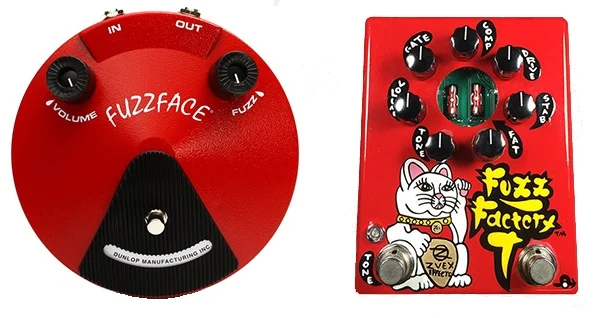
How to Use a Fuzz Pedal
Fuzz, as a type of distortion, has a natural place in the signal chain, but where is that and how do we know that’s right? And by the way, how do we deal with all these knobs on the pedal? Let me show you.
Where to Place it in the Signal Chain
Unbeknownst to many, thanks to the dumb platitude of “break all the rules” in music, there is a specific order your pedals need to be in. This is defined by nature and logic and is more scientific than art-related. And it can be summarized like this:
- Dynamics, Filters, & Pitch Shifters
- Boost & Distortion
- Modulation
- Time
Fuzz is a type of distortion that needs to be fed your signal after you shape, clean, and tweak the waveform and frequency response to your liking. Because once you add in distortion, there’s no going back.
And because modulation and time-based effects react to the signal you feed them, it makes sense to get distortion out of the way before then too. Use your compressor, equalizer, and pitch shifting first, then boost to feed your fuzz pedal the high gain it needs.
Understanding the Knob Settings
Although you’ll find some fuzz pedals adding in an EQ stage and other nonsense, typically you’ll have two or three knobs tops. The main one is the Volume knob (sometimes just called Fuzz or Drive) that defines the sound of the distortion by allowing you to drive it harder and thus chop the waveform harder.
You’ll usually find a Tone knob that lets you sweep a shelf boost around to define the brightness. The Sustain knob does what you expect, letting you choose how long your notes ring on for.
Sometimes you’ll see a Shift knob that gives you control over the mids so you can scoop or boost for more definition and warmth. Others will give you a Level knob that lets you control the gain at the output.
Some change the definition and will call the level knob ‘volume’ and call the volume knob ‘fuzz.’ That’s easy to figure out once it’s in your hands. The best fuzz pedal will never be confusing, so don’t worry about it too much.
